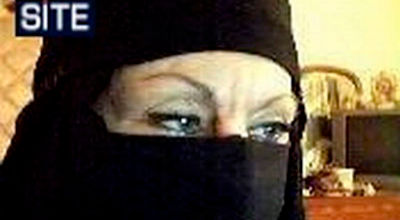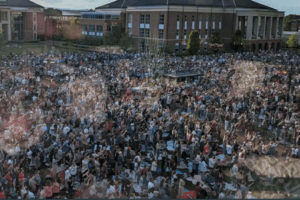The Cause
LaRose remained infatuated with Muslim men and Islam throughout the first half of 2008. But shortly after she converted, she stopped taking her new religion seriously. Pledges to stop drinking fell away. She never visited a mosque. She never learned how to properly pray.
Her waning interest fit an often flighty personality. In Texas, she had worked in a nursing home. But living outside Philadelphia, she held no job and struggled to pass the time while Gorman traveled.
She had her cats, Klaus and Fluffy, chatted on the phone with her sister in Texas and played games on websites like pogo.com. She also flirted with men in chat rooms and became obsessed with fantasy warrior stories—she read Shogun and watched the movies Spartacus, Braveheart, 300 and Troy.
Not until six months after her online conversion to Islam would she re-engage. In addition to passing time watching action movies, LaRose became riveted by violent YouTube videos of Israeli attacks on Palestinians and American attacks on Iraqis.
The videos of dead and wounded children moved her most. Sometimes while she watched, she could hear the young American children in the duplex below hers, laughing and playing. The disconnect infuriated her. No one seemed to know or care about the plight of the Palestinians. It was so unfair.
By summer 2008, LaRose was posting jihadist videos on YouTube and MySpace. She used various names online, including Sister of Terror, Ms. Machiavelli and Jihad Jane. During the next year, she exchanged messages with avowed jihadists—people with codenames such as Eagle Eye, Black Flag, Abdullah and Hassan—as well as with a woman in Colorado who seemed a lot like her.
LaRose didn’t try to hide her posts. She didn’t know how. Whenever she wanted to have a private discussion with Eagle Eye, she simply let him take remote control of her computer so he could ensure the secrecy of their chat.
Eagle Eye seemed careful, brave and righteous. He claimed to be on the run from Pakistani authorities and to have participated in the 2008 Mumbai attacks in which terrorists killed 166 people. In mere months, LaRose grew to trust him implicitly. She asked what she could do to help.
His first request seemed innocent enough: Send money to your Muslim brothers and sisters, he told her. So she did, dipping into cash that her boyfriend gave her.
LaRose knew that sending money to people who might be jihadists could be illegal, but who was watching her? Among those she helped: a Cairo cab driver who wanted $450 to fix his broken taxi.
At one point, she also tried to send $440 to a Somali man who wanted to start an online forum for an al-Qaida cell. She soon discovered that Western Union didn’t serve war-torn Mogadishu.
The Pledge
In January 2009, al-Qaida operatives asked LaRose to do more. They wanted her to become a martyr.
She agreed, and by February sent an online message pledging to use her blonde hair, green eyes and white skin to “blend in with many people … to achieve what is in my heart.”
A month later, LaRose also agreed to an overseas rendezvous with Eagle Eye, to marry him and help him get “inside Europe.”
Finally, in late March, Eagle Eye asked LaRose to commit her words to deeds. Travel from Pennsylvania to Europe, he said. Find Vilks, the Swedish artist who has blasphemed the Prophet Mohammad. Then shoot him—six times in the chest.
LaRose felt torn.
She wanted to say yes to Eagle Eye instantly. It would be an honor to become a martyr, she thought. Few sisters received such an opportunity. Plus, she wanted to make Eagle Eye proud. He was so religious, and though she had never seen his face, she had come to love him—not in a romantic sense but more like a brother.
But there were other considerations. Her elderly mother had recently moved to Pennsylvania to live with her, and her boyfriend’s ailing father also lived in the duplex. Whenever her boyfriend traveled for work—often—she was left to care for them.
Sitting before the keyboard, she read and reread Eagle Eye’s message: “Go to Sweden…And kill him.”
She would have to choose one path or the other—an exciting life as jihadist or a mundane one as caretaker.
She chose jihad.
“I will make this my goal,” she promised, “’til I achieve it or die trying.”
Patiently, she awaited further instructions from Eagle Eye. But she didn’t keep a low profile.
Throughout the spring and into mid-summer, LaRose drew more and more attention to herself, posting jihadi videos, anti-Zionist rants and solicitations to raise money.
Then, on a humid day in mid-July, a stranger approached the duplex near Philadelphia and rapped on her door. LaRose didn’t answer, and the man left his business card behind. When she picked it up, she rushed to her computer.
LaRose sent two messages—one to a high school student 150 miles away and another to her al-Qaida handler on the other side of the world.
The messages were the same: The FBI was on to her.
HOW THIS SERIES WAS REPORTED:
JANE’S JIHAD is based on six months of reporting in Pennsylvania, Texas, Maryland, Colorado, Washington, D.C., and Ireland. The accounts, including the thoughts and actions of characters in the stories, are based on court records and other documents, many of them confidential, as well as interviews with people involved in the case. Reporter John Shiffman gained exclusive access to those documents and individuals. Many spoke only on condition of anonymity. In Ireland, the law forbids the government and defense lawyers from commenting until court proceedings are completed. In the United States, prosecutors do not typically comment before sentencing. The Reuters interview with Colleen LaRose, the woman who called herself Jihad Jane, is the only one she has granted
© 2012 Thomson Reuters. All rights reserved.
See an error in this article?
To contact us or to submit an article






















